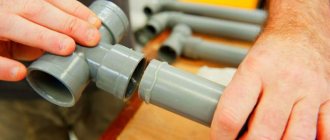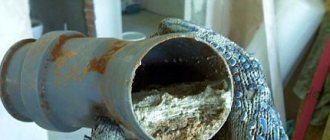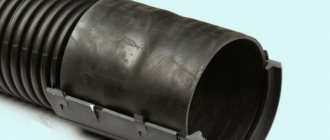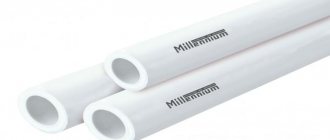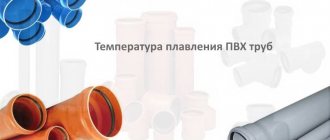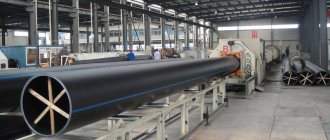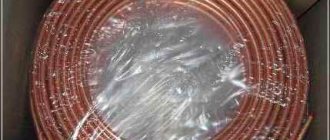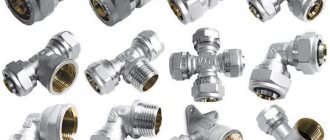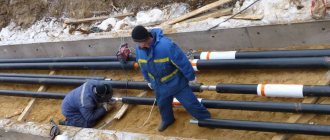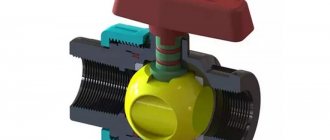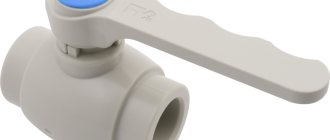“PVC” stands for polyvinyl chloride - a material that has good performance characteristics under heavy loads, as well as significant temperature changes. PVC pipes (white, orange, black, etc.) are very popular in today's communications products market. Often, on their basis, an external or internal sewerage network, a drainage system is built, cold and hot water is connected, and an electrical cable is laid.
Using PVC pipes, you can organize water supply and sewerage for a residential building or public facility without any special costs.
PVC: what is it
PVC pipe is highly durable. The material itself belongs to the class of plastics, which, upon completion of the formation of the product, does not lose its ability to be recycled; its melting point is 165-200 ° C. PVC is almost not subject to mechanical stress and other deformations, which is explained by the structure of the molecules and the structure of the polymer.
The material is thermoplastic, can be easily machined, and is easily welded when heated to a temperature of 200-300 °C. In addition, non-flammable PVC pipes are produced from it. Polyvinyl chloride is not sensitive to many acids, aliphatic, chlorinated and aromatic carbohydrates.
The strength of joints created by welding or adhesive is about 85-90% of that of the material itself. PVC is a good dielectric, meaning it does not conduct electricity. This property facilitates the use of the material in the production of smooth PVC electrical pipes.
Note! If the heating temperature of the pipe is more than 85 °C, the dielectric properties are lost.
The fire safety of PVC pipes determines their use when laying electrical networks for various purposes.
Electrical pipe made of polyvinyl chloride is used to protect television, electrical, and computer cables from all kinds of damage. The chlorine in its composition gives the polymer high fire resistance. The melting point of PVC pipes exceeds those made of polyethylene or polypropylene.
Which pipeline to choose for heating
The heating system involves the transportation of water, which is used to heat the room. It is logical to assume that for the heating system to operate efficiently, the temperature of the liquid that moves must be quite high. Regular plastic pipes expand, lose shape and sag when exposed to hot heating water. That is why their use is not recommended.
PVC pipes for heating
The best option for arranging a heating system is a reinforced plastic pipe, which best combines the positive characteristics of metal and plastic.
The following types of pipeline can be used for heating:
- Fiberglass reinforced pipe;
- Reinforced with perforated aluminum.
The reinforced line used to connect heating reduces the penetration of oxygen, which has a detrimental effect on the entire system, causing corrosion and destruction. Reinforced heating pipes are more durable, resistant to temperature changes and have a long service life.
In addition to heating, corrugated reinforced pipe can also be used for laying external cable lines and protecting electrical networks. The reinforced line has good dielectric properties.
Technical characteristics of PVC pipes
A comparison of the technical parameters of pipes made of PVC and other materials is given in the table.
Table 1
| Characteristic | PVC | Fiberglass | Stainless steel | Aluminium alloy | Unit |
| Density | 1,3-1,43 | 1,6-1,9 | 7,7-7,9 | 2,7 | kg/cm3 |
| Elastic modulus | 2,0-2,7 | 17-22 | 210 | 70 | GPa |
| Tensile strength (yield strength for PVC and metals) | 4-7 | 170-227 | 200-226 | 100 | MPa |
| Thermal conductivity | 0,13-1,63 | 0,58 | 17,5-58 | 201,3-221 | W/(K*m) |
Pipe production is based on GOST R 51613-2000, terminology is established by GOST R 52134-2003, weight, wall thickness and diameters are determined by GOST 18599-2001.
Pipes with the thickest walls can withstand heavy loads and are suitable for industrial use
The products have high elasticity and are resistant to deposit accumulation and rust formation. The smoothness of the inner surface prevents a decrease in pressure, and if it is an electrical pipe (white or gray), it does not interfere with cable pulling.
PVC pipes are resistant to stray currents, microorganisms, and ultraviolet rays. The white pipe is used to protect against electric shock if the wire insulation is damaged.
The minimum wall thickness for a polyvinyl chloride pipe is 1.3 mm; maximum – up to 36.7 mm for products used in industry.
Types of PVC pipes
There are several classification criteria that determine the classification of polyvinyl chloride pipes to one type or another. All types of products have different appearance, characteristics and properties. Smooth PVC pipes are:
- casing;
- sewer;
- electrical.
According to the bending radius, the PVC pipe can be flexible, very flexible and rigid, and according to the standard size - small, medium and large.
For external sewerage, you should use PVC pipes that can withstand the load, because such systems are laid underground
When installing the system in a house, you will need two types of products: external and internal PVC sewer pipes. The division of pipes is made based on the location of the system. The characteristics of PVC pipes for internal sewage allow them to be used for draining wastewater from apartments and private houses.
Note! The outer pipe is used for sewer networks with a large cross-section, as well as for drainage structures.
Characteristics of the work environment is another classification criterion. According to it, pipes are divided into non-pressure pipes, used to supply media without pressure, and pressure pipes, which provide for the creation of pressure. There is also a type of pipes that transport rarefied media. Corrugated PVC pipes (black, white, gray) can often consist of two layers - an outer corrugated one and an inner smooth one.
GOST 28117-89 defines the range of polyvinyl chloride pipes. Information about PVC pipes (what they are, explanation of symbols, assortment, requirements for production and use, technical parameters and features) can be found in regulatory documents.
Installation procedure for a pressure sewer system
Sewage pipe connection diagram.
Sewer pipes must be protected from depressurization to contain stress resulting from internal exposure to sewage. To accomplish the task, bends, tees, transitions and concrete support blocks are used.
When carrying out work on installing external sewerage from PVC pipes in a private house, you should take into account a number of features relating to design documentation.
The first thing to do at this stage is to determine the depth of laying PVC sewer pipes, which must be below the freezing point of the soil for the entire system to function without failure. The presence of a central sewer system should be taken into account, and if it is absent, PVC pipes are placed at a certain depth corresponding to the entrance to the cesspool.
Thanks to special manufacturing technology, products made from polyvinyl chloride are very light and easy to install. During installation of the system, one pipe can be easily inserted into another; there is no need to use complex welding equipment.
The material is stored under a canopy for 6 months from the date of installation. Transportation is carried out in compliance with the basic rules for the transportation of goods. Installation of the equipment is not particularly difficult and is carried out using sealing collars, clamps, and rubber gaskets.
Characteristics and features of flexible PVC pipes
Often there is a flexible pipe, the technical characteristics of which are determined by the properties of PVC. Such products have high ring rigidity. Thanks to this, the flexible pipe can withstand pressures of up to 120 atm. When heated, the elongation of the product is 5%.
Since the frost resistance of the material is low, thermal insulation is required. Flexible pipe is not able to maintain its properties if the temperature is below -15 °C.
Flexible pipe also has high strength and resistance to stress, but its scope of application is limited to a certain temperature range
Polyvinyl chloride has high light transmittance. For this reason, flexible pipe is often clear or painted in a variety of colors. Products made from this polymer have higher resistance to ultraviolet radiation compared to other plastics. They are very smooth outside and inside. If the temperature exceeds +78 °C, the rigidity of flexible pipes decreases.
Flared and square PVC pipes
A square PVC pipe with a wall of 2 to 3 mm is used for the construction of greenhouses and greenhouses. The frame is made from polyvinyl chloride tubes and attached to a wooden foundation. In agriculture, a square pipe is used to create and connect nipple drinking systems.
This shape of the pipeline holds the entire system vertically well, which is difficult to achieve with round products. It is very important to ensure that the nipple is installed perpendicular to the line on which the square pipe is placed. The range of products involves their production in different sizes and wall thicknesses.
Note! The standards do not prohibit coloring profiles by adding pigment. This is how you get, for example, a white or orange pipe.
Socketed PVC pipes differ from other types of products by the presence of a socket, which is equipped with an O-ring. This structure makes it possible not to use welding equipment when installing the system. The socket pipe is suitable for water supply and sewerage networks. It is made from unplasticized polyvinyl chloride, which is durable and resistant to aggressive environments.
Bell pipes are easy to install and require no tools.
The bell-shaped pressure pipe has a wide range. The operating pressure range is presented in the table.
table 2
| Dimensional relation | Pressure | Unit |
| SDR41 | 0,63 | MPa |
| SDR33 | 0,8 | |
| SDR26 | 1,0 | |
| SDR21 | 1,25 | |
| SDR17 | 1,6 |
The socket pipe is joined to other products to form a tight connection that is not affected by low or excess pressure in the pipeline.
Scope of application
The use of pipe materials in everyday life and industry is not limited to laying communications. However, the main areas of use remain pipelines for supplying drinking water, drainage, protecting electrical wires and communications.
PVC electrical pipes
Corrugation for laying electrical wires is a convenient, inexpensive, fireproof insulator that is used for wiring electrical networks in individual and industrial construction. PVC corrugation is laid indoors in an open way, on top of walls (fastening to the walls with clips) or the channels are walled up in concrete (hidden wiring).
Flexible materials are easy to install. They perform two functions:
- serve as an insulator for wires from external damage;
- perform the function of fire protection, since they do not support combustion in the event of a wiring fire.
We recommend that you read: Plastic corrugated pipes for laying electrical networks and sewer systems
Corrugated pipes differ in diameter (the range varies from 16 to 50 mm) depending on the power of the wires being laid. So 32 diameters are used to insulate wiring between electrical panels, 25 for wiring to distribution boxes, and smaller diameters to sockets and switches. Corrugation 16-20 mm in diameter is also used for laying communication networks (Internet, telephone). Available in coils of 20, 50 and 100 m or linear meters.
Note! Corrugated pipes are equipped with a special device - a broach, for easy cable placement.
For laying electrical communications in office and industrial buildings, rigid PVC pipes are used. They are sold in segments of 2-6 m.
Water supply
For the installation of water supply networks, uPVC pipes are used, which are resistant to pressure from a centralized water supply. These pipe materials have high chemical resistance and antibacterial properties, which, coupled with their smooth walls, makes them not only environmentally friendly and safe, but also recommended.
PVC-U pipes for water supply systems are light gray. Installation is carried out in a socket, without the use of threaded connections or glue. External communications need insulation.
Installation of pressure water pipes is carried out using special glue, in a socket on fittings. To do this you need:
- cut the pipe perpendicular to the guide axis;
- chamfer;
- coat the cut with a special cleaner, which pre-softens the material;
- coat the pipe and fitting with glue, connect with physical force, inserting the pipe until it stops;
- rotate the pipe a quarter turn for better distribution of the adhesive base;
- the result of the manipulations will be an even bead of adhesive mass at the border of the fitting, which is removed with a clean rag.
Note! When mechanically damaged, PVC pipes become vulnerable to stress. Transportation should be carried out without dragging, only in a horizontal position.
The disadvantages of PVC products include their difficult disposal, since at insufficient combustion temperatures this material releases toxic substances.
Sewerage
PVC-U sewer pipes for external installation are distinguished by their bright orange color. These are products made from unplasticized polyvinyl chloride, which are resistant to mechanical loads. There are pressure and non-pressure materials. For sewerage and removal of atmospheric water from the site, non-pressure varieties are mainly used.
Manufacturers offer corrugated and smooth PVC sewer products. Corrugated ones are made with a double wall (smooth pipe inside) and simple ones, the inner wall of which is also corrugated. Corrugation is used here to increase resistance to mechanical loads.
Note! For drains from washing machines and dishwashers, gray corrugated hoses with a diameter of 25-40 mm are used.
Installation of sewer pipes is carried out in a socket. For internal installation, gray pipes with a diameter of 50-110 mm are used. The outer pipe can be from 110 to 250 mm in diameter. Segments of finished products on sale vary from 50 cm to 8 meters.
We recommend that you read: Production and use of PVC pipes
When installing drainage systems, remember the required slope of 2 degrees. A smaller angle of inclination can cause water stagnation and freezing of the system. At a higher rate, the flow flows at such a speed that it does not have time to entrain heavy particles of mechanical impurities (for example, sand), which contributes to the formation of blockages.
Features of pipe selection
When selecting products, special attention is paid to the marking of PVC pipes. Deciphering it is not difficult. Usually indicated:
- PVC type;
- type of bell;
- size ratio;
- outer diameter size;
- wall thickness;
- appointment;
- manufacturing standard.
The color code for PVC pipes is as follows: gray (or black corrugated) - for internal sewage systems; orange or yellow – for external networks; polyvinyl chloride pipe for casing wells - white or blue. The inner surface of corrugated PVC pipes is white or light gray.
Pipes used for casing wells are most often produced in white or blue.
Additional characteristics of PVC pipes can always be found in the documents for its manufacture.
According to their strength class, products are divided into 3 groups:
- light (L);
- average (N);
- heavy (S).
The permissible depth of its occurrence when laying a pipeline underground depends on whether the pipe belongs to a particular strength class. The light group is capable of withstanding 2 kN/m2 and is designated SN-2, medium - 4 kN/m2 (SN-4), heavy - 8 kN/m2 (SN-8).
Black PVC pipe is usually used for open laying of cables and wires. This color reduces exposure to ultraviolet rays.
Waste water removal
When choosing sewer pipes for water drainage, pay attention to the internal diameter and wall thickness
Such parts have different dimensions. The most popular product is considered to be with a diameter of 110 mm. All these parts are indicated in its markings. For example, “NF PVC EU - 110 x 3.2” indicates that such a PVC pipe has a diameter of 110 mm (with a wall thickness of 3.2 mm). According to GOST, it is intended for wastewater disposal.
When sanitary fittings are used or a drain manifold is used, the plastic parts can have different diameters, ranging from 32 mm to 63 mm. Sewer drains require large holes. In this case, diameters ranging from 75 mm to 710 mm are used. When private equipment is used, a diameter of 110 mm is used.
Parts intended for sewer work have a straight tip and a special socket joint. If the diameter is small, limit yourself only to a straight tip. To determine the minimum internal diameter, you need to look at GOST, where all applicable sizes are indicated in the table. Taking into account the proposed sizes of parts on the market, use:
- for washbasins - 32 mm;
- for shower -40 mm;
- for sewerage - 110 mm.
Especially for universal installations, GOST provides the corresponding dimensions. The dimensions of pipes sold often do not correspond to standard ones. Therefore, when making a purchase, you need to choose a diameter so that its size is slightly larger.
When selecting sewer parts, the selection criterion is the wall thickness.
The fact is that all free-flow pipes are selected regardless of internal pressure. Almost any sewer system is non-pressure. Therefore, the best option when choosing such a part is to ensure high strength of the product wall. It must withstand the entire volume of liquid passing through it. She should not be afraid of the mechanical influences that the external environment may have. Therefore, when choosing sewer pipes, two indicators must be taken into account:
- The internal diameter through which the entire volume of waste will pass.
- The wall thickness provides high mechanical strength.
